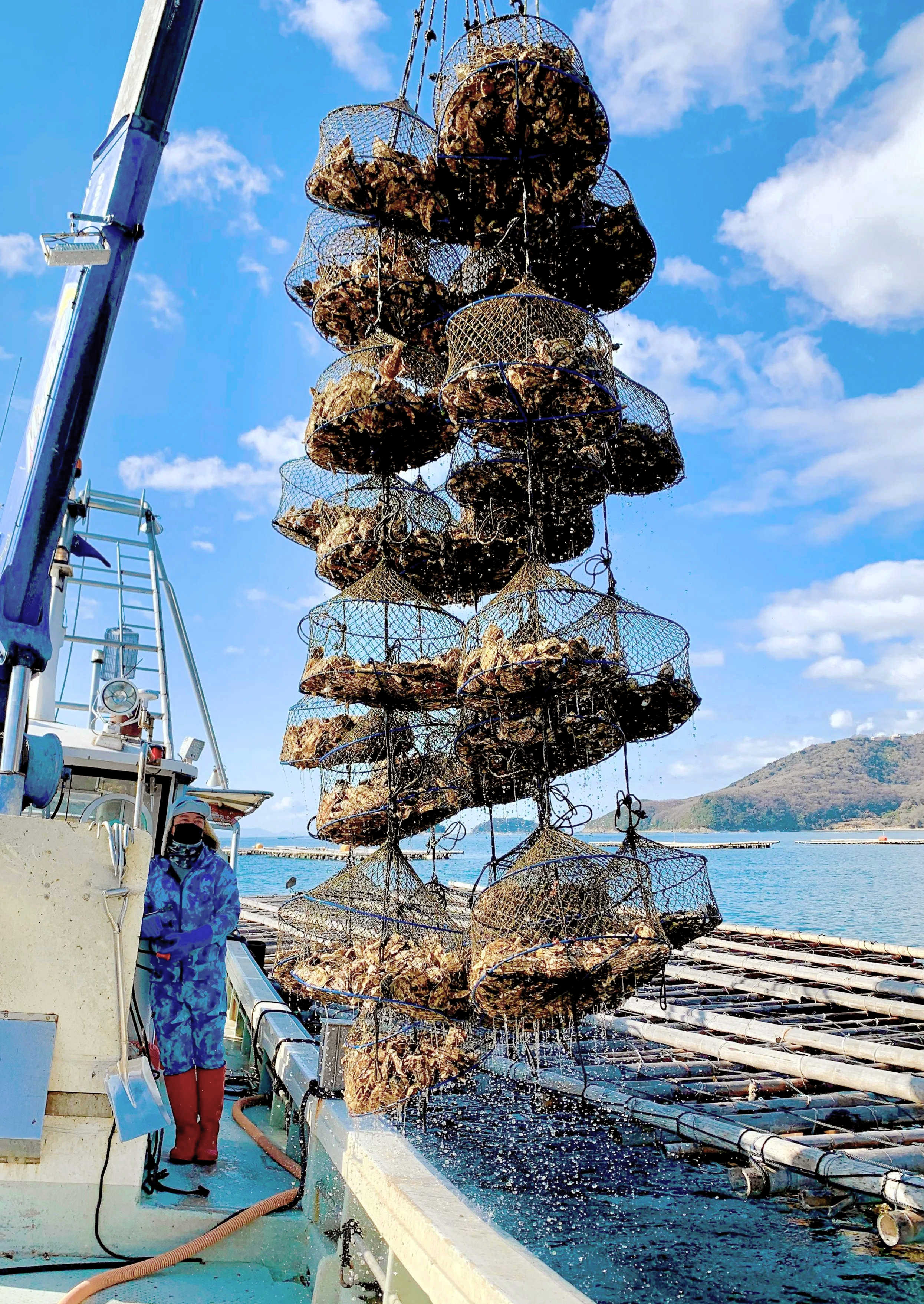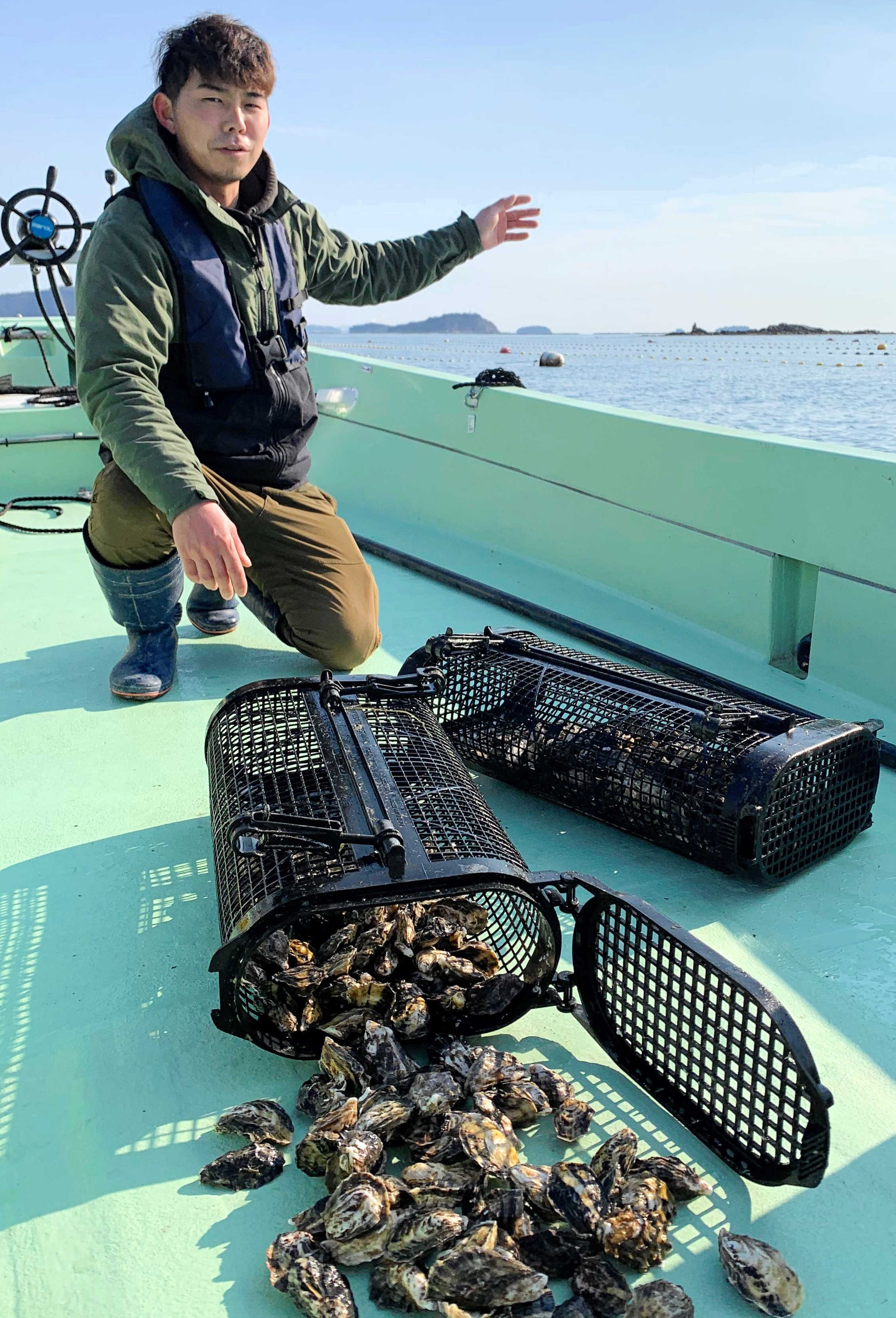Oysters from the Harima Sea: Blessings from the land nurture the sea
On days when there are no winter monsoon winds, the waters of the Harima Sea (also known as the Harimanada Sea) are incredibly calm. Bamboo rafts float intermittently on the sea’s surface, shining brilliantly in the sunlight. Up ahead some islands such as the Ieshima Islands also come into view. A boat pulls up alongside the raft, revealing a net basket filled with oysters. The oysters, which have grown large in just over half a year, make you realize the richness of Harima's land, rivers, and sea.

Oysters are unloaded after cleaning the deposits and rehanging them into the sea, off the coast of Tatsuno City.
‘Harima Gosen (lit. five rivers) and spring water
.jpg)
Oyster farming began in the Harima Sea properly around 1975-1985. The first were Aioi and Ako, but later production areas rapidly expanded to Boze and Aboshi in Himeji City, and Murotsu and Iwami in Tatsuno City, and then to Takasago. Annual production is approximately 8,000 tons of oysters, ranking fourth in Japan after Hiroshima, Miyagi, and Okayama.
Each fishing port is lined with farmers’ direct sales stores, and the number of charcoal grill shops is also increasing. There are many restaurants around JR Banshu Ako Station and Aioi Station where visitors can enjoy dishes such as the classic fried oysters, okonomiyaki called ‘kakioko’, hot pot, and pizza.
Although this variety of oyster is late to the game and is still not well-known in Japan, its reputation is steadily growing, and the locals are happy to get comments of how the oysters are “large and fluffy” and “don’t shrink when heated”.
Let’s take a look at why it’s considered to be of high quality. When I asked Keisuke Tanida of the Hyogo Prefectural Fisheries Technology Centre, he answered, “First of all, the Harima Sea is full of nutrients.” The nutrients in the ocean that nurture oysters are evident in the amount of phytoplankton present. Nutrients flow into the Harima Sea from the land through the ‘Harima Gokawa’ (lit. Harima five rivers) i.e. the Chikusa River, Ibo River, Yumesaki River, Ichikawa, and Kako River that originate in the Chugoku Mountains, as well as spring water from the ocean floor. Looking at the average indicator concentration of chlorophyll in phytoplankton, Harima Sea has a concentration of 3.4 to 6.5 micrograms per litre. This is more than twice the value found in Hiroshima and Okayama.
’1 year oyster’
One of the pitches often seen in Harima is ‘1-year oysters’. This refers to how the period from the start of summer aquaculture to harvest is so short, lasting just six months to a little less than a year. While some production areas take more than two years to harvest, 1-year oysters selling point is their rich growing environment, nutritional content, and not overpowering flavour.
Of course, there are also challenges for this variety of oyster. Most of the scallop shells with oyster larvae attached to them, called ‘seed plates’, are purchased from other prefectures.
“To grow seed oysters, you need a place with large tidal fluctuations, and the main reason we cannot do that here is because there is not much of it in the Harima Sea,” explains Tanida. The price of seed plates fluctuates depending on the seed production in other prefectures, which often places pressure on business management. It is said that there were years when the price of seed plates, which usually cost about 10 to 13 yen each, soared to 80 yen.
Single seed

Kotaro Tomita with single-seed oysters grown in a special cage, off the coast of Ako City
As securing locally produced seeds and seedlings becomes a major issue, small-sized ‘single seeds’ that can be found at oyster bars are becoming more and more popular. Unique home-seed collection and production techniques have been developed by the Fisheries Technology Centre and growers.
The larvae floating in the sea are attached to plastic bottles, and when they grow, they are placed in Australian-made cages and raised undersea. As they grow while tossed around by the waves, they develop a round, deep shell. Kotaro Tomita of Tomita Suisan or Tomita Fisheries (Sakoshi, Ako City), which sells single seeds, says, “they are small and have a light taste, so even people who don’t like raw oysters find them pleasant to eat.” He feels the efforts to develop a market for this product are producing positive results.
Protecting the undersea environment

Seto Inland Sea with oyster rafts and islands floating off the coast of Tatsuno City
Activities to protect fishing grounds are also being taken seriously. Oysters are packed with nutrients, including taurine, glycogen, zinc, and vitamins, which are effective for fatigue recovery, but because they are voracious eaters, they also produce a lot of waste, and if left untreated, the ocean floor environment will endure negative effects. For this reason, the rafts are spaced far enough apart to allow seawater to pass through easily, and when the fishing season ends, the rafts are moved to clean the sediment and allow the fishing grounds to rest and refresh. We are also working on countermeasures against ‘fallen oysters’ that rot and deteriorate fishing grounds. A group led by Koichi Isobe, a producer at the Murotsu Fisheries Cooperative, devised a ‘falling oyster catcher’ that catches oysters that would otherwise fall to the ocean floor once they grow to full size. By setting up a net with a diameter of 1.5 meters, resembling an upside-down umbrella, many of the fallen oysters, which make up 20 to 30 percent of oysters grown are not lost.
In 2015, their efforts to protect the marine environment while increasing productivity were selected for the Minister of Agriculture, Forestry and Fisheries Award at the National Young and Female Fishermen Exchange Conference. “We want to raise awareness of environmental conservation and promote the recycling of forest and ocean resources so that we can continue to grow oysters in the bountiful ocean” Mr. Isobe explains his focus on the area’s natural environment as a whole.
This year, due to the lower seawater temperature that is necessary for oyster growth and favourable growth of plankton, there is a good harvest. What is troubling is the drop in demand from restaurants due to COVID. But on the other hand, new forms of consumption are expanding, such as supermarkets selling oysters in their shells to households.
If you can get your hands on oysters sold in their shell, consumers should definitely try steaming it with sake. Pour enough sake to cover the oysters laid out in a wide, shallow pot and heat. Enjoy the flavour that is a concentration of the nature of Hyogo, while also remembering the consistent efforts of producers to protect the rich fishing grounds here.
Written by Kazuyoshi Tsujimoto, Manager of Corporate Planning Department, Senior Staff Writer at The Kobe Shimbun (Daily Newspaper)
This article was first published on 27th February 2022 in The Kobe Shimbun as part of a series entitled "Wind, Water and Earth...Hyogo's Terroir"
Date : 2024.05.29



